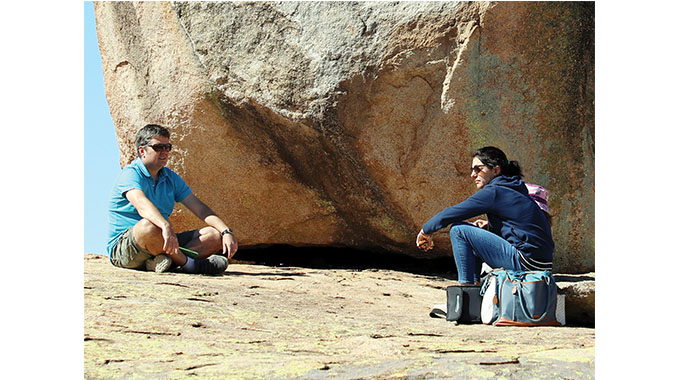Domestic tourism picks up the pieces

Mashudu Netsianda, Senior Reporter
TOURIST attractions around Bulawayo reopened last week following Government approval for the restart of tourism activities, with facilities recording a significant increase in domestic visitors.
Although the figures were not immediately available, Chronicle newscrew yesterday observed a significant number of tourists accessing facilities surrounding the city.
Lockdown regulations for the tourism and hospitality sector were recently partially relaxed by Cabinet allowing the two sectors to resume limited operations. Tourism activities were halted in March as part of measures to curb the spread of Covid-19.
Safari operations and national parks are allowed to re-open to help boost domestic tourism while restaurants are now allowed to serve sitting customers within their premises, but using only half their licensed capacity.

The tourism industry is the formal sector hardest hit by Covid-19 and the resulting bans and restrictions on travel, resulting in tour operators and hotels closing indefinitely owing to lack of business.
Government is, however, engaging stakeholders to build up domestic tourism, which over the years was overlooked in favour of international travellers.
Chronicle newscrew yesterday visited selected tourist attractions surrounding Bulawayo and observed that the areas were teeming with domestic tourists.
At Matopos National Park, which opened on Tuesday last week for day trippers only, some tourists, mostly families and couples could be seen relaxing at Matopos Hill Safari Lodge and Maleme Dam picnic sites while others were busy sight-seeing the famous World’s View where there is Cecil John Rhodes’ grave.
To access the monument, it costs US$4 or $255 per head.
Matopos National Park is situated on a granite-decorated terrain of the Matobo Hills. When Rhodes then chairman of the British South Africa Company (BSAC) — famed for colonising Zimbabwe — set his eyes on this marvel of a hill, he developed a serious affection for it and re-named it “The View of the World”.

The Matobo Hills is an area of high botanic diversity, with over 200 species of trees recorded in the national park, including the mountain acacia, wild pear and the paperbark acacia.
There are also many aloes and wild herbs and over 100 grass species. Many types of rare endemic plants have been recorded.
Matopos National Park has a wide diversity of fauna. Game include white rhinos, sable antelopes, impala, bush bucks and leopards.
The national park contains the world’s densest population of the leopards due to the abundance of hyrax, which make up 50 percent of their diet.
Matopos National Park contains the highest concentration of black eagles, and breeding pairs of these birds, worldwide. Tourists who spoke to Chronicle urged providers of tourism facilities to consider coming up with affordable rates as a way of boosting domestic tourism.
Mr David Chidzera of Harare, who was part of a group of tourists on a day visit at Matopos National Park said: “We were in Bulawayo where we are working on an irrigation project. We then thought of just passing through Matopos National Park and surely this a beautiful place and quite amazing. It is my first time to visit Rhodes’ grave.
“We applaud the Government for relaxing lockdown regulations, which has seen reopening of tourism for locals. We however, urge relevant authorities to come up with regulations that promote domestic tourism by ensuring that tourism companies come up with affordable rates for locals.”

A couple from Harare, which was on a visit at Rhodes’ gravesite, but however declined to be named, said the tour was part of its belated 10th wedding anniversary celebrations.
“We are here to celebrate our belated 10th wedding anniversary in a quiet and serene environment and therefore, we thought Matopos National Park would be an ideal place. We are visiting this place for the second time in five years and the view is quite magnificent and we are grateful to the Government for relaxing lockdown regulations and allowing reopening of tourism facilities,” said the couple.
Mr Nhlanhla Sithole of Bulawayo could not hide his excitement as he posed for a photo shoot with his colleagues at Tshabalala Game Sanctuary, about 10km out of Bulawayo along Matopos Road
“I have been longing to visit this place since the lockdown. I am an adventurous person who loves nature and outdoor life and that is why you are seeing me here, together with my friends. We just came here to relax and enjoy the tranquility of mother nature,” he said.
Tshabalala is a wildlife sanctuary of thorny bushveld and hosts a variety of birdlife and wildlife. Some of them include guinea fowl, francolins, giraffe, zebra, warthog, impala, antelope and many species of wild birds and waterfowl.
Visitors are allowed to leave their cars in Tshabalala and walk through the wilderness and experience the sights and sounds on foot. Driving and cycling is also permitted and horse rides can be arranged. The Sanctuary is open from 6am to 6pm and there is an entrance fee of US$4.
Mr Bruce Thompson, who operates tour operating companies and lodges in Hwange and Kariba, said high rates were a major setback towards the growth of domestic tourism.
He said presently, it was difficult for tourism companies to come up with subsidised rates for the local market without foreigners coming in, due to the high costs of maintaining the facilities.
“In order for us to cater for the local market, we need to come up with subsidised rates largely because a majority of locals don’t have disposable income required to travel as much as they would like. However, in as much we want to promote domestic tourism, we really need foreign tourists because it is not sustainable to solely rely on locals,” he said.
“Government did the right thing by reopening tourism industry and what is important for such players is to follow the WHO health guidelines and regulations. We are actually doing that at our lodges by ensuring that our clients wear facemasks, they are hand sanitised and have their temperatures checked before accessing our facilities.”
A National Museums and Monuments of Zimbabwe tour guide, said since their reopening, they have been recording a steady increase in the number of locals visiting their sites at Matopos National Park.
He, however, said most of the visitors were from outside Bulawayo. As the Chronicle newscrew drove out of Matopos National Park, the numbers of tourists entering the park continued to swell.
Zimbabwe Parks and Wildlife Authority (Zimparks) public relations manager Mr Tinashe Farawo said their organisation is set to get a boost in its conservation operations following the reopening of the tourism industry.
Zimparks relies heavily on tourism receipts for its conservation efforts and had of late began to struggle due to lack of funds.
Zimparks is the custodian of Zimbabwe’s premier tourist destination — the Victoria Falls and several national parks around the country.
Mr Farawo said they hope to scale up and meet their mandate with the opening of the tourism space.
“Now that Government has given us the greenlight to open our national parks to visitors, albeit locals, we have made a decision to open most of the parks. You are aware that as ZimParks, we largely rely on tourism to fund our conservation activities and this includes law enforcement as well as reacting to human/wildlife conflict incidents,” he said.
Mr Farawo said Zimparks had put in place measures to ensure that the national parks don’t turn into new Covid-19 hotspots. “All our staff are undergoing the mandatory Covid-19 tests so that they are ready to receive visitors. We are also regularly sanitising areas which visitors patronise and we will also be doing the basic screening checks for our visitors,” he said. “We want to assure visitors that as ZimParks, we are doing everything possible to guarantee their safety and thus urge them to visit our national parks.”
The global Covid-19 pandemic has disrupted global value chains as countries sealed their borders and international airports as part of a host of measures to contain the disease. With international travel restrictions, there have been virtually no tourists from North America, Europe or Asian countries that provide most of Zimbabwe’s tourists. — @mashnets












Comments